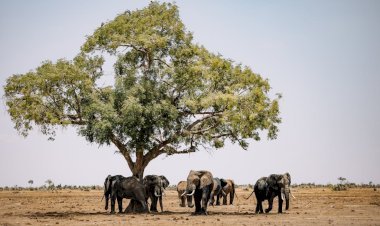Why Laos Is Called the Land of a Million Elephants
Discover why Laos is called the “Land of a Million Elephants,” exploring its history, culture, symbolism, and modern conservation efforts.

Nestled in the heart of Southeast Asia, Laos is a country known for its serene landscapes, Buddhist temples, and rich cultural traditions. Yet, one of the most captivating titles associated with Laos is its historic nickname — “Land of a Million Elephants.” This evocative phrase sparks curiosity among travelers and historians alike. Did Laos truly have a million elephants? Or does the name symbolize something deeper about its culture and history?
To answer this, we must journey back to the origins of Laos’ kingdoms, its cultural identity, and its enduring bond with one of the world’s most majestic creatures — the elephant.
Historical Background of the Nickname
The title “Land of a Million Elephants” originates from the ancient Kingdom of Lan Xang, which was established in 1353 by King Fa Ngum. The name Lan Xang Hom Khao translates to “Land of a Million Elephants and the White Parasol.”
-
Lan Xang’s Military Strength: At the time, elephants were not just animals but powerful weapons of war. Armies equipped with war elephants commanded respect and fear across the region.
-
Symbol of Royal Power: A king’s prestige was measured by how many elephants he possessed. Lan Xang, blessed with fertile forests and rivers, was home to a vast elephant population.
-
Political Symbolism: The abundance of elephants became synonymous with strength, unity, and prosperity, hence embedding the title into Laos’ identity.
While it is unlikely the kingdom ever had exactly one million elephants, the term was a poetic way to emphasize power and abundance.
The Symbolism of Elephants in Lao Culture
Elephants have always carried profound cultural meaning in Laos:
-
Sacred in Buddhism – In Buddhist tradition, elephants represent wisdom, patience, and enlightenment. The white elephant, in particular, is revered as a divine animal connected to the birth of the Buddha.
-
Strength and Prosperity – For Lao people, elephants symbolized prosperity, protection, and endurance. They were essential in sustaining livelihoods and communities.
-
Folklore and Mythology – Lao legends often feature elephants as protectors of the land, linking them to divine blessings and national pride.
Thus, the elephant became more than an animal; it evolved into a spiritual and cultural icon.
Elephants in the Lan Xang Kingdom
During the height of the Lan Xang Empire, elephants shaped nearly every aspect of society:
-
Military Use: Elephants were armored and trained for battle, often leading charges that struck fear into opponents.
-
Transportation: They carried heavy loads through the rugged landscapes of Laos, enabling trade and communication across regions.
-
Agriculture: Elephants plowed fields, moved logs, and supported the local economy.
The kingdom’s might was often illustrated by its elephant corps, which impressed both allies and rivals across Southeast Asia.
The Royal White Elephant Tradition
White elephants, though not albino, are rare elephants with pale skin and unique features. In Southeast Asia, they were seen as a divine blessing:
-
Symbols of Kingship: In Laos, possession of a white elephant was considered proof of a ruler’s legitimacy.
-
Royal Prestige: The “White Parasol” in the kingdom’s name refers to royal protection, often paired with the spiritual significance of the white elephant.
-
Regional Importance: This belief wasn’t unique to Laos; neighboring Thailand and Myanmar also revered white elephants. However, in Laos, the symbolism tied directly to its identity as Lan Xang.
Elephants in Modern Laos
While elephants once roamed freely across the Lao forests, their population has drastically declined:
-
Deforestation and Habitat Loss: Logging and urbanization have reduced elephant habitats.
-
Population Numbers: Today, estimates suggest only 800–1,000 elephants remain in Laos, split between wild and domesticated groups.
-
Conservation Efforts: Organizations like the Elephant Conservation Center in Sayaboury are working to protect and rehabilitate elephants.
Though the days of a “million elephants” are long gone, modern Laos is striving to preserve the legacy through conservation and eco-tourism.
Tourism and the “Land of a Million Elephants” Today
The nickname continues to play a vital role in promoting Laos as a tourist destination:
-
Elephant Sanctuaries: Visitors can experience ethical elephant tourism at sanctuaries in Luang Prabang, Sayaboury, and Vientiane.
-
Festivals and Events: Annual elephant festivals celebrate their importance to Lao culture and attract global travelers.
-
Eco-tourism: Travelers are encouraged to support responsible elephant tourism, ensuring elephants are not exploited for rides or shows.
By embracing sustainable tourism, Laos maintains the spirit of the “Land of a Million Elephants” while safeguarding its natural heritage.
The Cultural Legacy of the Name
The name “Land of a Million Elephants” is not just a historic title; it remains embedded in Laos’ cultural fabric:
-
Art and Literature: Elephants are depicted in Lao paintings, crafts, and poems as symbols of strength and pride.
-
National Identity: Even though the Lan Xang Kingdom no longer exists, modern Laos continues to celebrate its legacy.
-
Festivals and Daily Life: Elephants are often featured in traditional festivals, blessing ceremonies, and spiritual practices.
The name serves as a reminder of the country’s glorious past and its responsibility to honor and protect its heritage.
Comparison with Other National Nicknames
Southeast Asian countries often carry poetic nicknames:
-
Thailand – “Land of Smiles” (hospitality and friendliness).
-
Cambodia – “Kingdom of Wonder” (mystical temples and landscapes).
-
Vietnam – “Land of the Ascending Dragon” (linked to its myths).
Among these, Laos’ title, rooted in elephants and royal power, is uniquely tied to both cultural heritage and natural abundance, setting it apart in regional identity.
Quick Facts: Land of a Million Elephants at a Glance
| Aspect | Details |
|---|---|
| Kingdom Name | Lan Xang Hom Khao |
| Translation | Land of a Million Elephants and the White Parasol |
| Founded | 1353 by King Fa Ngum |
| Symbolism | Elephants = strength, prosperity, and spirituality |
| Modern Population | 800–1,000 elephants (approx.) |
| Conservation Hotspot | Elephant Conservation Center, Sayaboury |
FAQs About the Land of a Million Elephants
Q1: What does “Lan Xang” mean?
It means “Land of a Million Elephants,” referring to the ancient kingdom of Laos founded in the 14th century.
Q2: Did Laos really have a million elephants?
Not literally — the phrase was symbolic of the kingdom’s power, wealth, and large elephant population.
Q3: How many elephants are left in Laos today?
Conservationists estimate only 800–1,000 elephants remain, both wild and domesticated.
Q4: Can tourists see elephants in Laos?
Yes, ethical sanctuaries in Luang Prabang and Sayaboury allow tourists to observe and interact with elephants responsibly.
Q5: Why are elephants important in Lao Buddhism?
Elephants, especially white elephants, symbolize wisdom, strength, and divine blessings in Buddhist tradition.
Conclusion
Laos earned its poetic title “Land of a Million Elephants” through the strength, symbolism, and abundance of elephants in the Lan Xang Kingdom. While the country no longer has the vast herds it once did, elephants continue to shape its culture, religion, and tourism.
Today, the phrase is more than a nickname — it is a call to remember the past while protecting the future. As travelers explore Laos’ temples, rivers, and sanctuaries, they also play a part in preserving the legacy of a land where elephants once ruled both battlefield and belief.
Read More: Top 20 Things to Do in Kenya: Adventures, Safaris & Culture

 alissaperry
alissaperry 






















